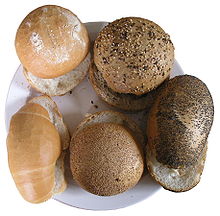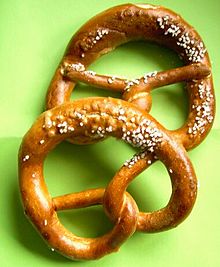Biscuits
Small baked goods are all baked goods that meet the requirements for bread and weigh less than 250 grams. This includes rolls and pretzels . The term definitions can be found in the guiding principles for bread and biscuits .
Every region of Germany has its own typical biscuits. Typical include the Hamburg round pieces , the Kölner Röggelchen , the Berliner Schrippen , the pretzel pretzel , which is particularly popular in southern Germany, or the Kaisersemmel , which is very common in Bavaria. Special pastries, such as caraway sticks, poppy seed, sesame or onion rolls, as well as sweet rolls and croissants are increasingly being eaten.
Small baked goods are divided into:
- Smooth biscuits with a smooth surface such as Röggelchen, Wasserweck, Hamburger Rundstück
- Curved pastries with notches or incisions and a higher proportion of crust, for example Berlin rolls, sliced rolls, baguette rolls
- Pretzels
- shaped biscuits such as braided rolls, pretzels or croissants
- Scattered rolls, for example, with sprinkled oil seeds, spices
- Small baked goods with special ingredients and properties such as
- Raisin rolls with at least 15 percent raisins
- Buns with at least eight percent oil seeds
- Whole grain rolls made from at least 90 percent whole grain meal products
- Bran rolls with at least ten percent edible bran
In the GDR , small baked goods were defined by TGL 23 305. According to this, small baked goods had a fat and / or sugar content of less than 10% and weighed a maximum of 180 g.
A distinction must be made between small baked goods and pastries , which, regardless of size and weight, are not included in food law in Germany. "Fine baked goods differ from bread and small baked goods in that their fat and / or sugar content is more than 10 parts per 90 parts of grain and / or grain products and / or starches ."
In Austria, small baked goods are sold by the piece, in contrast to Italy, for example, where small baked goods are sold by weight, i.e. the baked goods are weighed.
Pieces of dough make it possible for sales stands in supermarkets, train stations or petrol stations to offer pastries and bread freshly baked in baking stations without a bakery being available. The baking of dough pieces can also be done by unskilled workers or by anyone at home and led to a significant shift in sales from the bakers to the new suppliers of small baked goods. Such baked goods are always available fresh and crispy, but when stored (for example from Saturday to Sunday) they become harder and more inedible than pastries with a different type of dough, which can only be offered directly by bakers without intermediate storage.
See also
swell
- ↑ Guidelines for bread and biscuits , published in the German Federal Gazette No. 184 of September 28, 2005
- ^ AID information service on nutrition (ed.); Gesa Maschkowski: password food. 3. Edition. AID, Bonn 2010, ISBN 978-3-8308-0935-7 .
- ↑ Wilfried Seibel: Fine baked goods. Behr, Hamburg 2001, ISBN 3-86022-852-8 , p. 18.

